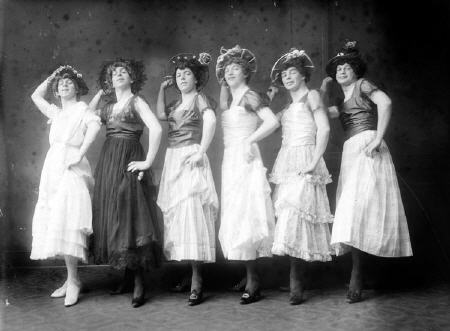No, that’s not a typo, and no, I didn’t post the wrong picture–at least, not if the attributions in the Holsinger Digital Collection at UVA are correct. Today’s stroll down history lane with the Virginia Glee Club covers an era in their history which is, perhaps justifiably, forgotten–their days as a musical theatre troupe.
To understand how a group founded on moonlight serenades, that eventually became a serious musical organization, spent time in the footlights with greasepaint and drag clothing, it’s helpful to go back to the re-formation of the Glee Club in 1910. At that time, the Glee Club, after a few years without any qualified student direction, reconstituted itself, responding, according to University historian Philip A. Bruce, to the disbanding of the musical theatre group the Arcadians. Through contemporary eyes, it’s easy to read this as meaning that the students from that group of musical players saw the error of their ways and became serious choral singers. Apparently not. Instead, this incarnation of the Virginia Glee Club appears to have arrived to fill a market void and spent at least some of its time doing real musical theatre.
And by musical theatre, I mean drag. The photo above, taken by the Holsinger photographic studio on April 4, 1916 (note the date), is attributed to the Glee Club with a question mark, as if to say, “No way!” Alas, other documentary evidence says “Way!” I have in my possession a copy of the April 1, 1921 edition of the Yellow Journal, the University’s anonymous satirical newspaper, in which a reviewer describes a performance of the Glee Club’s April Fools show for that year, “The Visiting Girl”:
“The Visiting Girl” presented by the University of Virginia Glee Club, John Koch, president, director and chief actor. Jefferson Theatre as an April Fool joke, April 1, 1921. We last saw this show in December and later we saw it in Richmond during February. If it hasn’t improved, and we doubt whether it has improved, we advise you not to go to see it. … The chief attraction of the show is Jack Parrott as a girl and John Koch as a rube. Jack plays his girl’s part very well, though he is a bit awkward. The girls’ chorus looks about as much like a bunch of girls as a litter of pups does. …
I could write it off as satire, but then there’s the ad in the back pages of the paper (the ads, while written to be funny, all are for real products or events):
TO-NIGHT
University Glee Club
IN A MUSICAL COMEDY
Suggestion: Why not cut out the “musical”?
Suggestion: They might cut out the “comedy” too.
The YJ’s hostility to the performance is partly a put-on (they spend the whole issue carping about class issues, and there’s “no one notable” in the Club), but the event is all real. It may well have been an April Fools tradition, judging from the dates of the evidence points, but the events were clearly real.
I would be remiss if I didn’t point out other photos from this era in the Holsinger archives. Yeah, the Glee Club did some of their “musical comedy” in blackface. I guess this isn’t surprising in a group doing musical comedy in the South in the early 20th century, but it’s still sobering to realize that the Glee Club really was of its time.


VERY interesting Tim…
I enjoyed the other pictures you referenced as well. Such a good example of both how things change with the times and of how things evolve through a variety of incarnations to become the “traditions” we love so much…
Aha, the story goes deeper. Turns out The Visiting Girl is well attested; a description of the musical is in a UVA Library online exhibit, and it entered into production in 1920. Yes, the cover of the score says “University of Virginia Glee Club.”
Oh my god, I can’t tell you how uncomfortable those blackface photos make me.
You’ve really done some crackerjack work uncovering the history of Club!
Jeff–yeah, I’m with you on that point. I’ve known the Holsinger archive for a long time–over ten years–but until I uncovered the information about The Visiting Girl I never understood how to tell a story around these odd drag and blackface pictures. The drag one makes me laugh, but the blackface ones make me think hard about the University’s history and its role in the big questions of the 19th and 20th century.